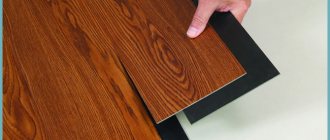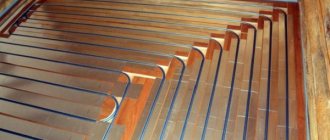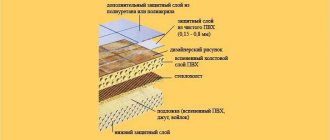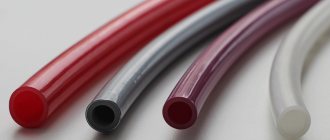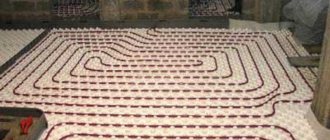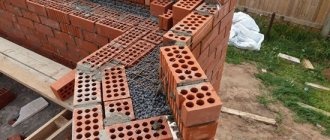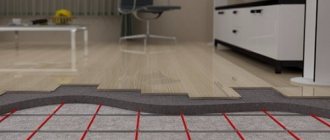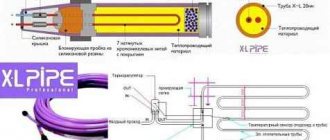When arranging a water-based underfloor heating system, special attention should be paid to the composition of the multi-layer "cake", which is mounted on the base of the floor. One of its important components is underfloor heating insulation. To make the right choice of heat insulator, you need to know the features of popular materials on the market. The lack of insulation, inappropriate characteristics of the heat insulator or errors in its installation lead to a decrease in the efficiency of heating the room and premature failure of the system.

Why thermal insulation is necessary
The water circuit heats the floor surface due to thermal radiation, while the heating is directed not only upwards, but also downwards. Without installing a heat-insulating layer under a warm floor, a significant part of the radiation will be absorbed by a base made of concrete or wood. If a cold basement or ground is located under the room where the floor heating circuit is supposed to be installed, heat loss can reach 40%. If there is a heated room below, the heat loss will be about 20%.
A decrease in the efficiency of an underfloor heating system leads to an increase in energy costs. In addition, the boiler unit is forced to operate in the increased power mode, which is why it wears out faster. To avoid problems associated with reducing the life of the equipment, as well as to reduce financial costs for heating, it is necessary to insulate the base of the floor using a suitable insulation.
On top of the heat-insulating layer, which is mounted on a prepared waterproofed base, it is recommended to lay a roll of foil-clad material or immediately use an insulation with a metallized coating. The foil reflects heat radiation upward, increasing the efficiency of the heating circuit.
Thermal insulation under a warm floor performs several functions at once:
- prevents heat loss through the ceiling and at the same time does not let the cold through from below;
- promotes the distribution of thermal radiation over the entire surface of the floor covering and, accordingly, uniform heating of the room;
- increases the inertia of the "pie" - after the boiler is turned off, the floor remains heated for a long time, this saves energy;
- serves as a sound insulator and dampens vibration, which increases the acoustic comfort in the house.
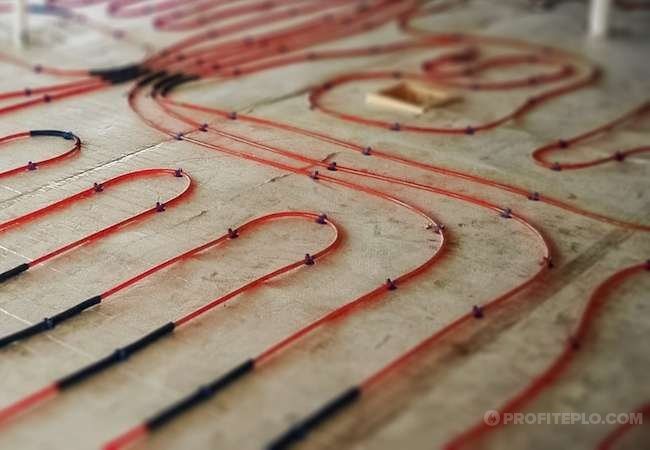

Insulation thickness
On the Russian market there is a wide selection of heat-insulating materials of domestic and foreign production. When choosing a suitable option, you need to pay attention to the following parameters:
- the ability to withstand the loads from the heating circuit, cement-sand screed, flooring;
- resistance to dynamic influences that arise during the operation of the floor, and return to its original form after reducing the impact;
- health safety;
- resistance to biological damage (violation of the tightness of the circuit due to water hammer can lead to the development of fungus);
- fire resistance.
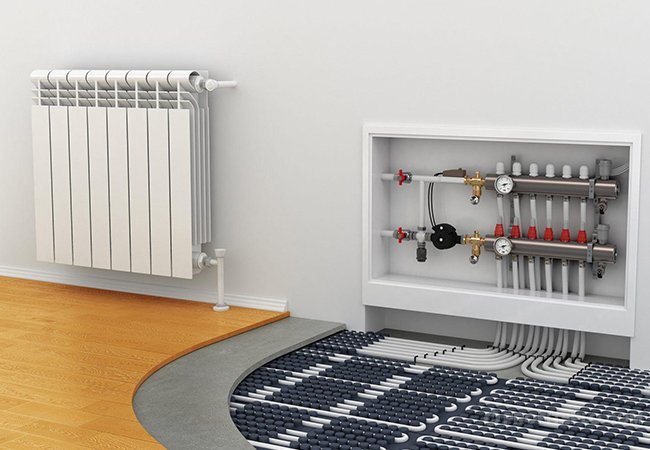

To correctly determine the required thickness of the thermal insulation layer, it is necessary to take into account the thermal conductivity of the selected material, as well as the intensity of heat loss through the ceiling in the cold season.
Information regarding the popular thermal insulator, expanded polystyrene, is presented in the table below.Based on the table, you can calculate the thickness for any insulating material if you know its thermal conductivity coefficient.


Types of heaters under a warm water floor: pros and cons
Manufacturers produce a wide range of heaters that are suitable for use when arranging a warm floor. Thermal insulation for the floor is produced in the form of roll and slab materials, in addition, specially developed profile systems are on the market. It is worth choosing taking into account not only the functional parameters of the insulation, but also the features of the installation of the material and the system as a whole.
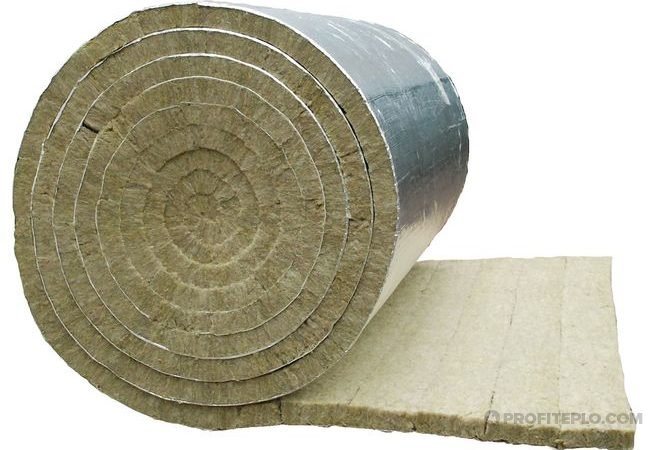

Thermopol is the optimal insulation for a water-heated floor
Another material that I often use as insulation for laying a water-heated floor. The advantage of such insulation is that the pipes fit into special grooves. The speed and simplicity of laying the insulation itself and pipes is the main advantage of such insulation. Any thickness of the same extruded polystyrene foam can be laid under it. When pouring, pipes in the grooves are better protected from damage. You can lay boards or plywood and calmly roll a wheelbarrow or walk with buckets without stepping on the pipes of the water-heated floor. There are specialized mats with the same special grooves, but prices for them sometimes go beyond all reasonable boundaries.
Roll materials
Rolled heat insulators (penofol and its analogues) are a foamed polymer material with a one-sided or double-sided foil outer coating. The advantages of roll materials include:
- small thickness (up to 12 mm), which makes them convenient for use in rooms with low ceilings;
- the presence of a reflective metallized layer;
- ease of installation - lightweight roll material is rolled out over the surface with a reflective layer up, cut to size with ordinary scissors, the joints are glued with aluminum tape.
Despite its advantages, roll materials are not without drawbacks. They reflect heat rays well, but poorly insulate the system from freezing from below. Laying in two layers with a shift is allowed so that the seams of the joints do not coincide. Penofol and similar materials with a metallized coating can be used in combination with a thin plate heat insulator, which will act as a cold insulating substrate. This will help to reduce the overall thickness of the "pie" in rooms under which the soil or cold basement is located. It is important to know that aluminum foil is damaged in an alkaline environment when pouring a sand-cement screed. There are two ways to work around the problem:
- Use rolled material, the metallized surface of which is a foil protected by a polymer film, or made of lavsan with metallized inclusions.
- It is safe for aluminum to use a plaster-based screed solution instead of cement.
Aluminum tape used for gluing seams must have a polymer outer coating.
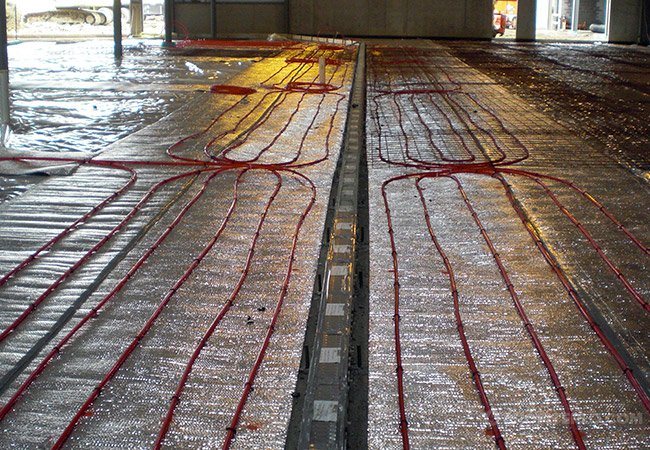

Slab materials
Materials of this type are suitable for use in rooms with a ceiling height of 260 cm, since the thickness of the slabs “eats up” several centimeters. For the manufacture of rigid plates used:
- polystyrene (expanded polystyrene);
- extruded polystyrene foam;
- bung;
- mineral wool.
The most functional option is extruded polystyrene foam. It is characterized by high density and quickly regains its shape after high point loads. Expanded polystyrene material is not afraid of moisture, it is mounted with a continuous flooring under the screed. Polyfoam, unlike its "brother", is vapor-permeable and less resistant to deformation. It is recommended to mount the heat-insulating layer in the cells between specially mounted lags, closed with waterproofing.This will reduce the risk of destruction of the insulation under strong mechanical stress. The main advantage of foam is its low price. Cork thermal insulation for a warm floor is effective in its insulating properties, but it also requires installation between the lag and the arrangement of steam and waterproofing, since the cork is a hygroscopic porous material. In addition, it is important to consider that this is one of the most expensive materials. Rigid mineral wool slabs are suitable for insulating the subfloor under the underfloor heating circuit, but the fibrous material needs to be reliably protected against possible water leakage. Mineral wool slabs of small thickness are laid in the living room. So that the insulation does not squeeze under loads, it is advisable to install the installation between the logs.
The cost of insulation for a water-heated floor
It remains to voice the cost of the insulation.
Thermopol - we use products. The cost depends on the density and ranges from 190 to 230 rubles per m2. If the base is not level, you have to use additional fasteners. Added 20-30 rubles per square meter.
Extruded polystyrene foam - the cost of such a material is in the region of 4500 rubles per cubic meter. In a cube of 33 m2 with an insulation thickness of 30 mm. It turns out that 1 m2 costs 135 rubles. Reinforcing mesh. It is needed not so much for reinforcement as for fastening pipes with a certain laying step, and so that the pipes of the water-heated floor do not float when pouring. It is necessary to take with a margin for overlap. The cost of a 3 mm mesh with a cell of 150 * 150 mm is around 60 rubles. With an overlap coefficient, it will cost 70 rubles. Fasteners in the form of fungi for insulation 20-30 rubles. In this case, it is required. Electric clamps. Needed for attaching pipes to a reinforcing mesh. This is about 20 rubles. The cost of the entire set is 255 rubles.
Underfloor heating penofol type. The cost of a high-quality substrate, with a thickness of 10 mm, is in the region of 100 rubles per m2. Then you can go in two ways. Either use a reinforcing mesh or use a 6 mm dowel clamp to secure the electrical cable. In the first case, the cost will be 170 rubles per m2, in the second 110 rubles per m2. But as a heater, this option does not work. We wrote about this above. If we take the golden mean. Then, as a heater for a warm floor, it is best to use the option with a thermal floor. We are ready to design and install a turnkey water heated floor
Social Like
Profile systems
There is a growing demand for specialized profile systems - mats made of extruded polystyrene foam. Hydropellet punching technology makes it possible to obtain panels of a certain size and profile. The panels can have a laminated outer skin. The profiled edges of the panels allow quick installation of a one-piece thermal insulation coating. On the front side of the panels there are special shaped projections, between which it is easy to lay the heating circuit pipes, without the need to use additional fasteners. This greatly simplifies and speeds up installation work. Profile systems are produced in the form of panels of various thicknesses - from 10 to 34 mm. Their only drawback is their high cost.
Conclusion on the topic
The need for thermal insulation of warm floors is obvious, but it is important to choose the best option for a heat insulator. Extruded polystyrene foam is considered the leader among heaters. It is practical and easy to install. If there is a financial opportunity, it is recommended to purchase a profile system, but ordinary board material has also proven itself well. Foam plastic is also in demand, but this is due to its cheapness. Roll materials have their own specifics, their use is determined by the height of the ceilings.Cork and mineral wool are not the most budgetary option, in addition, their installation is complicated by the need to provide reliable waterproofing to protect against accidental leaks of the circuit. If the floor heating circuit is electric, it is still required to insulate the floor in order to minimize heat leakage, but at the same time, the use of a profile system does not make sense, and there are no increased requirements for the protection of hygroscopic heat insulators.
Types of heaters


Minvata
Good price, high thermal insulation properties, simple installation, sound absorption, fire resistance (class NG). The best option for electric floors (the melting temperature is not lower than 600 degrees), for water floors there are two serious disadvantages: the thickness is greater than that of other heat insulators, and hygroscopicity.
When wet, the material loses more than half of its heat-insulating properties, i.e. if a pipe leaks, the insulation will have to be changed.
Environmental cleanliness is relative. Some varieties include phenol. Basalt dust generated during installation is harmful to the respiratory organs of the installer.
During installation (the process of installing a warm water floor with your own hands) mineral wool (if you still chose it), in addition to the waterproofing substrate, you also need a vapor barrier layer on top, because the material has high vapor permeability. The vapor barrier membrane should be laid with the discharge side away from the insulation, i.e. up.
Expanded polystyrene
Many types, from regular foam to dense extruded PPS. For the installation of floors (water heated floors, installation technology), a material with a density of at least 35 kilograms per cubic meter is chosen.
Depending on the specifics of laying (on the ground, on a warm floor, in the southern region, on permafrost, etc.), the thickness of the insulation for a warm water floor can be 3-20 centimeters. Using EPPS, insulation of the smallest thickness can be performed.
